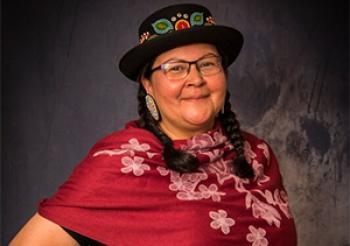Image Caption
Summary
Local Journalism Initiative Reporter
Windspeaker.com
Traditional helper Elaine Kicknosway wants to make sure no more First Nations children belong to “this era of child welfare.”
“We have these different labels which are placed upon us as children: neglected, abandoned; in that light of knowing our mothers or community would not raise us,” she said. “I was born in that era.”
Kicknosway, of Peter Ballantyne Cree Nation, was one of four people – two Elders and two youth – who spoke Jan. 19 at the Assembly of First Nations’ first of five virtual conferences on First Nations Child and Family Services and Self-Determination.
Kicknosway was joined by Knowledge Keeper Edmond Sackaney and youths Erickson Owen and Cheyenne Mandamin to talk about what they lost growing up away from their families and communities. They spoke of the changes they would like to see in the family and child welfare system as First Nations move forward in implementing C-92, An Act respecting First Nations, Inuit and Métis children, youth and families.
Kicknosway said First Nations children were removed from their homes through policies for Indian residential schools, day schools, the Sixties Scoop and child welfare. She referred to this as an “era of when it was blacked-out time”. Taken children were not always told that they were First Nations or what communities they came from.
Kicknosway is a Sixties Scoop survivor, having grown up in several foster homes, all of them non-Indigenous. She managed to find her way home with help from an understanding foster family, but no help from the system.
“There’s always that ongoing, ‘Oh, you were in child welfare’ or ‘You’re a foster kid’ … all these different labels…. It’s not our shame; we were just kids. It’s not our families’ shame; they were struggling. It’s not our grandparents’ shame,” she said.
Bill C-92 recognizes Indigenous peoples' jurisdiction over child and family services as part of their right to self-governance. The federal law came into force Jan. 1, 2020.
“We want no Indigenous children in care. We want no Indigenous children in stranger foster care. That should be achievable in five years,” said Mary Ellen Turpel-Lafond, law professor at the University of British Columbia, who also spoke at the virtual forum.
However, one year after the act has became law, only one First Nation has had their childcare law come into effect.
As of Jan. 8, Wabaseemoong Independent Nations controls its own child welfare under Anishinaabe law.
Indigenous Services Canada Minister Marc Miller told viewers that as of Dec. 23, 2020, there were 26 confirmed Indigenous governing bodies representing 64 Indigenous groups and communities who had submitted notice of requests to exercise jurisdiction under the act.
Those 26 Indigenous governing bodies have received nearly $12 million in capacity-building funding, he said.
Miller pointed out that $542 million over five years had been announced by his government to support communities at various stages of capacity building. That funding does not include infrastructure development, such as new offices to house child and welfare services.
The funding committed by the government, said AFN Manitoba Regional Chief Kevin Hart, who is the social development portfolio holder, has clearly “missed the mark.” The AFN has called for $3.5 billion over five years to do the necessary work.
“In many cases First Nations are building from the ground up. We need to establish new laws and reinvigorate traditional laws after years of colonialism, after years of our laws being outlawed and banished altogether through federal and provincial law,” said Hart.
“It’s time that Canada steps up and funds First Nations based on actual needs in a way that allows for planning and stability so that First Nations can make this transition in a good way.”
Turpel-Lafond agreed.
“At some point we’re going to have to get Canada to step up, support us … making sure we have funding to bring these principles to life and to make sure that anytime a First Nations child’s life is being considered somewhere that these principals are there,” she said.
The legislation is strong, though, she said, putting the best interest of the child at the centre.
Turpel-Lafond said that everything First Nations need to move forward on implementing their own laws and in decision-making and enforcing their jurisdiction over their children and families can be found within this legislation.
The legislation gives First Nations and provinces one year to put into place a coordinating agreement, although that timeframe may be extended, she said, due to complications presented through measures to control the coronavirus pandemic. Whatever the timeframe, though, if that undertaking is unsuccessful, First Nation law takes precedent.
However, Turpel-Lafond admitted, some provinces are having difficulty letting go of their authority.
“I do monitor court decisions in the first year and I look at how there are still big decisions being made about the placement of First Nations kids and they’re not taking into account the federal law adequately. That’s not what we would like to see,” she said.
Miler agreed that some provinces were more willing than others to “undertake that discussion.” He said the federal government would do the necessary work with the provinces for the shift in authority.
“We’re trying to achieve major change. It’s not on our shoulders completely. Systems need to change and they were very slow to change.… We are shifting, but we need to make sure these shifts are meaningful and they continue at a good pace,” said Turpel-Lafond.
Local Journalism Initiative Reporters are supported by a financial contribution made by the Government of Canada.

